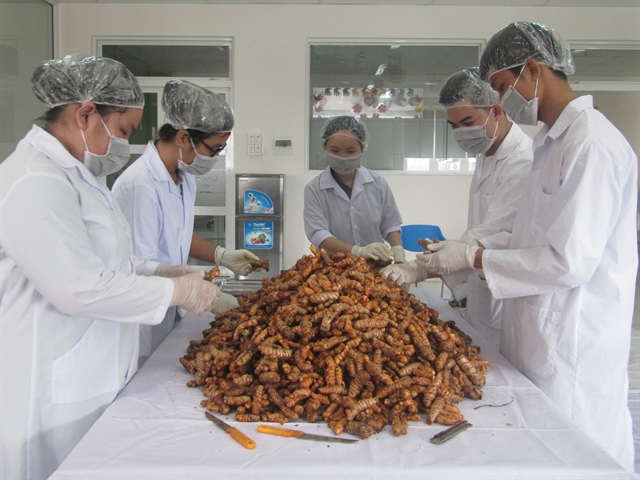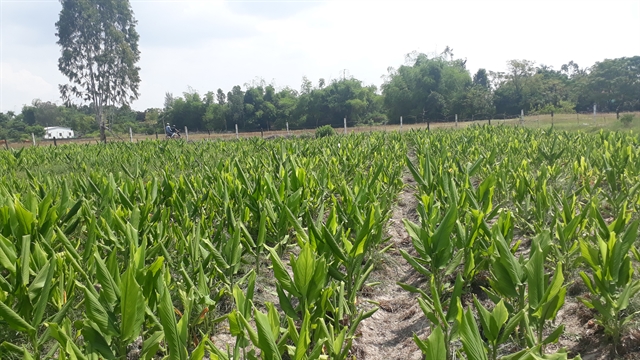
Students select fresh turmeric for starch production in a lab at the Đà Nẵng-based Đông Á College. Students and lecturers at the college have been researching and applying curcumin extraction from turmeric in pharmaceutical production. VNS Photo Công Thành
Turmeric is usually used in cooking to add a spicy flavour to food, but it can also be used to treat gastric problems and to heal scars as well as a natural dye for traditional textiles in Việt Nam.
Recent research has also found that curcumin – a component extracted from turmeric - can be used to cure cancer and prevent other serious diseases.
Lecturers and students at the food technology and biology faculty at Đông Á College have successfully developed a cold-drying process for turmeric and a method to extract oil from the peel.
The results help ease high-blood pressure, gastritis, wounds, cancer and improve skincare.
“Turmeric is usually processed after being ground down and heated, but we use a fridge set to 20-25 degrees Celsius. This process retains 1.39 per cent of the natural curcumin content in turmeric powder,” said lecturer Nguyễn Thị Việt Hải.
“Turmeric powder can be easily used as daily drink to prevent tumours and ulcers, reducing gastritis and helping women recover after giving birth,” she said.
Practical education
Lecturer Nguyễn Phước Minh said the cool dried turmeric would help boost business start-up among young students, and further scientific studies and research into turmeric and other spices.
Minh said students could learn from their innovations to find different methods to produce medicine or functional food from spices after leaving college.
“We offer young students the chance to take part in research at the lab from their first year, and they can develop based on their initial projects. It means that students can put what they learn on paper into practice,” he said.
Following the project, farmers in Quảng Nam Province – a major supplier of turmeric – can double from sales.
“They used to earn VNĐ11,000 (US$0.5) from one kilo of fresh turmeric for cooking, but now they make more from their crops that are used for functional food or traditional medicine,” Hải said.

Turmeric starch produced from a research project involving lecturers and students at Đông Á College in Đà Nẵng.
“Every 100kg of fresh turmeric is processed into 3kg of cold-dried turmeric starch, while a bottle of 250ml is sold for VNĐ180,000 ($7.8),” Hải said.
She said farmers could earn more from essential oils oil and compost from turmeric peel.
Nano-curcumin
Associate Professor Nguyễn Minh Chính, dean of the pharmacy faculty at Đông Á College, said curcumin extracted from turmeric was a crucial part of the research project at the college.

A spice farm in Hòa Vang District, Đà Nẵng. VNS Photo Công Thành
He said curcumin was widely used in pharmaceutical production, and cost VNĐ100 million ($4,300) per kilo.
“It’s expensive. Every three tonnes of turmeric only provides 1.5kg of curcumin and 30 litres of essential oils. Meanwhile, turmeric grown in the central and Central Highlands regions has a high rate of curcumin (about 98 per cent),” Chính said.
“Nano-curcumin pharmaceutical production could bring huge revenue of VNĐ150 million ($6,500), five times as much as cooking ingredients,” he speculated.
“I mean that turmeric can be extracted from the flesh, peel and essential oil. Nothing becomes waste,” he said.
Chính, 65, said nano-curcumin pharmaceutical production would help develop a large farming industry in central Việt Nam.
Chairman of Đông Á College Nguyễn Thị Anh Đào said research into turmeric and nano-curcumin production had set a positive science-based curriculum for thousands of student in the central region.
She said it would encourage students to conduct more research, while promising future career orientations after leaving college.
Nguyễn Thị Ngọc Linh, a third year student of biology and food technology faculty, said she had learnt a lot from studying the deeper components of turmeric.
She said she enjoyed practical time in the lab working on different spices to produce functional food and cures for deadly diseases including cancer.
Võ Thị Bích Thủy from the Quality Assurance Testing Centre in Đà Nẵng said the project would be applied for mass production.
She said tests revealed that 100 grammes of turmeric starch contained 1.39 per cent of curcumin.
She said turmeric was used as a positive cure for burn patients or scars.
Đà Nẵng, in co-operation with Danapha Pharmaceutical JSC, had launched a farm that met the World Health Organisation-guided Good Agricultural and Collection Practice (GACP-WHO) standards in Hòa Vang District to provide products to be used in oriental medicine. — VNS